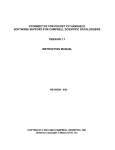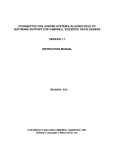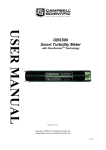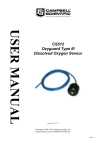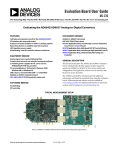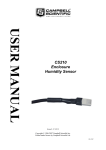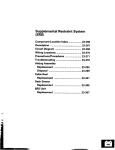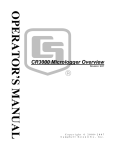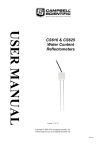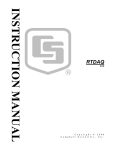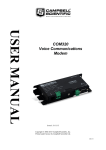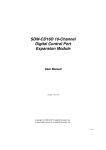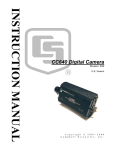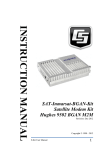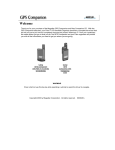Download PConnectCE for Pocket PC Manual
Transcript
PConnectCE for Pocket PC Handheld Software Support for Campbell Scientific Dataloggers Version 2.1 Revision: 4/06 S o f t w a r e C o p y r i g h t © 2 0 0 1 - 2 0 0 6 C a m p b e l l S c i e n t i f i c , I n c . C o p y r i g h t © M e a s u r e T e k , I n c . License for Use This software is protected by both the United States copyright law and international copyright treaty provisions. You may copy it onto a single Pocket PC handheld computer to be used and you may make archival copies of the software for the sole purpose of backing-up CAMPBELL SCIENTIFIC, INC. software and protecting your investment from loss. All copyright notices and labeling must be left intact. This software may be used by any number of people, and may be freely moved from one handheld computer location to another, so long as there is not a possibility of it being used at one location while it’s being used at another. The software, under the terms of this license, cannot be used by two different people in two different places at the same time. For example, if you want to install it on two handheld devices at the same time, you must have two licenses. Limited Warranty CAMPBELL SCIENTIFIC, INC. warrants that the installation compact disk (CD) on which the accompanying computer software is recorded and the documentation provided with it are free from physical defects in materials and workmanship under normal use. CAMPBELL SCIENTIFIC, INC. warrants that the computer software itself will perform substantially in accordance with the specifications set forth in the Instruction Manual published by CAMPBELL SCIENTIFIC, INC. CAMPBELL SCIENTIFIC, INC. warrants that the software is compatible only with Pocket PC handheld computers. CAMPBELL SCIENTIFIC, INC. is not responsible for incompatibility of this software running under any operating system other than those specified in accompanying data sheets or Instruction Manuals. The above warranties are made for ninety (90) days from the date of original shipment. CAMPBELL SCIENTIFIC, INC. will replace any CD or documentation that proves defective in materials or workmanship without charge. CAMPBELL SCIENTIFIC, INC. will either replace or correct any software that does not perform substantially according to the specifications set forth in the Instruction Manual with a corrected copy of the software or corrective code. In the case of significant error in the documentation, CAMPBELL SCIENTIFIC, INC. will correct errors in the documentation without charge by providing addenda or substitute pages. If CAMPBELL SCIENTIFIC, INC. is unable to replace defective documentation or a defective CD, or if CAMPBELL SCIENTIFIC, INC. is unable to provide corrected software or corrected documentation within a reasonable time, CAMPBELL SCIENTIFIC, INC. will either replace the software with a functionally similar program or refund the purchase price paid for the software. CAMPBELL SCIENTIFIC, INC. does not warrant that the software will meet licensee’s requirements or that the software or documentation are error free or that the operation of the software will be uninterrupted. The warranty does not cover any CD or documentation that has been damaged or abused. The software warranty does not cover any software that has been altered or changed in any way by anyone other than CAMPBELL SCIENTIFIC, INC. CAMPBELL SCIENTIFIC, INC. is not responsible for problems caused by computer hardware, computer operating systems or the use of CAMPBELL SCIENTIFIC, INC.’s software with non-CAMPBELL SCIENTIFIC, INC. hardware. ALL WARRANTIES OF MERCHANTABILITY AND FITNESS FOR A PARTICULAR PURPOSE ARE DISCLAIMED AND EXCLUDED. CAMPBELL SCIENTIFIC, INC. SHALL NOT IN ANY CASE BE LIABLE FOR SPECIAL, INCIDENTAL, CONSEQUENTIAL, INDIRECT, OR OTHER SIMILAR DAMAGES EVEN IF CAMPBELL SCIENTIFIC HAS BEEN ADVISED OF THE POSSIBILITY OF SUCH DAMAGES. CAMPBELL SCIENTIFIC, INC. is not responsible for any costs incurred as result of lost profits or revenue, loss of use of the software, loss of data, cost of re-creating lost data, the cost of any substitute program, claims by any party other than licensee, or for other similar costs. LICENSEE’S SOLE AND EXCLUSIVE REMEDY IS SET FORTH IN THIS LIMITED WARRANTY. CAMPBELL SCIENTIFIC, INC.’S AGGREGATE LIABILITY ARISING FROM OR RELATING TO THIS AGREEMENT OR THE SOFTWARE OR DOCUMENTATION (REGARDLESS OF THE FORM OF ACTION; E.G., CONTRACT, TORT, COMPUTER MALPRACTICE, FRAUD AND/OR OTHERWISE) IS LIMITED TO THE PURCHASE PRICE PAID BY THE LICENSEE. PConnectCE Table of Contents PDF viewers note: These page numbers refer to the printed version of this document. Use the Adobe Acrobat® bookmarks tab for links to specific sections. 1. Introduction..................................................................1 1.1 New Features in this Version....................................................................2 1.2 Contents of Shipment ...............................................................................2 2. Software Installation....................................................2 2.1 Initial Installation......................................................................................2 2.2 Installing the PConnectCE Upgrade .........................................................4 3. Connecting Your Pocket PC Handheld to the Datalogger ..............................................................5 3.1 Direct Serial Connection...........................................................................5 3.1.1 CS I/O Connection..........................................................................5 3.1.2 RS-232 Connection.........................................................................6 3.2 RF400 Radio Communication ..................................................................6 3.3 IR Communication....................................................................................6 3.4 Bluetooth ..................................................................................................6 4. Using the PConnectCE Software................................7 4.1 4.2 4.3 4.4 4.5 4.6 4.7 Configuring Stations.................................................................................8 Connecting to the Station........................................................................12 Viewing Data on the Handheld...............................................................19 Viewing Datalogger Program Files ........................................................20 Transferring Data to Your Desktop Computer .......................................21 PConnectCE Settings..............................................................................21 Updating Table Definitions for PakBus Dataloggers .............................22 i This is a blank page. PConnectCE for the Pocket PC Handhelds1 1. Introduction Welcome to PConnectCE for Pocket PC Handhelds support software for Campbell Scientific dataloggers. PConnectCE supports the CR10/10X, CR500/510, CR23X, 21X, CR7, CR200, CR1000, CR3000, CR10XPB, CR510PB, and CR23XPB dataloggers. PConnectCE software allows you to connect your Pocket PC handheld to a Campbell Scientific datalogger to perform all of the standard datalogger support functions, including: • check and set the datalogger clock • send and receive datalogger programs • view and edit input locations and labels • set flags and ports • collect data • access the datalogger’s remote keyboard mode through a terminal interface, and • view collected data in a tabular display. PConnectCE stores collected datalogger data in the handheld’s internal memory. (Expansion memory cards are not supported.) Using the data display feature, you can view this data while at the site. When the handheld is synchronized with the desktop computer, this data is moved to a specified data folder on the PC. New data from each station is appended to any existing data file on the PC. The synchronization process also synchronizes datalogger program files between the PC and handheld device. Files copied to the handheld device’s PConnectCE folder will automatically be transferred to the handheld during the next synchronization process. Using this process, you can store program files on the handheld device, and subsequently send them to the datalogger or use them for labels when viewing measurements (input locations). You can also retrieve programs from dataloggers to the handheld device, and use the synchronization process to copy them to the PC. If two different programs— one on the handheld device and another in PConnectCE’s programs folder on the PC—have the same name when you synchronize, the program file on the PC will overwrite the program file on the handheld device. (Note: PConnectCE does not support data collection from Campbell Scientific’s Storage Modules or Card Storage Modules.) 1 PConnectCE is a trademark of MeasureTek, Inc. 1 PConnectCE for the Pocket PC Handhelds 1.1 New Features in this Version Version 2.1 maintains all the functionality in previous versions, while adding support for the CR3000 datalogger. 1.2 Contents of Shipment The following items are shipped with PConnect: • PConnectCE software CD • PDA to CS I/O connector (for communication via a datalogger’s CS I/O port) • PConnect/PConnectCE PDA to RS-232 cable (for communication via a CR200’s, CR1000’s, CR3000’s, or CR23X’s RS-232 port) 2. Software Installation 2.1 Initial Installation PConnectCE requires a handheld computer running Microsoft® Pocket PC or Windows Mobile®, with a StrongARM, Hitachi SH3, MIPS, or Intel PXA250 processor. Computer requirements include a PC running a Windows-based, 32-bit operating system (Windows 95, 98, ME, NT, 2000, or XP) with a Pocket PC compatible version of Microsoft ActiveSync® installed.2 NOTES There is a difference in Pocket PC and Handheld PC. PConnectCE is not compatible with devices running the Handheld PC operating system. The PDA must be capable of serial communication, and a PDA to 9-pin female serial cable must be available to connect directly to the datalogger. Some PDAs are not capable of serial communication. Alternately you can communicate via IR using an SC-IRDA purchased from CSI or via Bluetooth using a third party Bluetooth to serial port adapter. Contact Campbell Scientific for a list of known compatible devices. Make sure ActiveSync is installed on your PC and that a device partnership has been established with ActiveSync for the handheld device. A "New Partnership Wizard" that sets up this partnership is automatically launched in ActiveSync the first time you connect your handheld device to your computer. For additional information, refer to the ActiveSync on-line help. 2 Microsoft, Windows Mobile, and ActiveSync are registered trademarks of Microsoft Corporation in the United States and other countries. 2 PConnectCE for the Pocket PC Handhelds Insert the PConnectCE compact disk into your CD-ROM drive and run the Setup.exe program from the disk. Follow the instructions on the screen to install the software. During the installation, you will be prompted for “Destination Location” for the software (the default is C:\Program Files\CampbellSci\PConnectCE). You will then be prompted to “Choose Working Folder” (default is C:\CampbellSci\PConnectCE). When you synchronize with the handheld device to download the PConnectCE software, a subdirectory for the device will be created in this Working Folder directory (e.g., C:\CampbellSci\PConnectCE\devicename). This subdirectory is where the data files retrieved using PConnectCE will be saved when you synchronize your handheld with the PC after data has been collected from a datalogger. This will also be the directory into which you will copy any files that should be transferred to the handheld for use with the datalogger, such as a new program file (*.DLD, *.CR1, *.BIN). After you have installed the software on your PC, synchronize with your handheld device using ActiveSync. This will install PConnectCE on the handheld. After PConnectCE is installed, you will be asked to ensure that no further steps are required on the handheld to complete the installation. On Windows Mobile devices that support landscape mode, you will receive the message, “The program you have installed may not display properly because it was designed for a previous version of Windows Mobile software.” This message can be ignored. PConnectCE has been installed and will operate on the device. Note, however, that PConnectCE does not support landscape mode. If the device is operated in landscape mode, part of the PConnectCE window will not be displayed. During the installation process an item will be placed on the handheld's Start | Programs | PConnectCE menu. Select this menu option to start the program. NOTE PConnectCE must be selected under ActiveSync’s Tools | Options, Sync Options tab for data to be transferred to/from the handheld when it is synchronized with the computer. It is selected when a check mark appears beside the application name in the Sync Options list. In most instances, PConnectCE is selected automatically, but with some devices the user must do this manually. If PConnectCE appears in the Sync Options list but its status is reflected as “Not Installed”, close ActiveSync and disconnect the handheld. When you reopen ActiveSync’s Sync Options list, PConnectCE should be available for selection. After installation, you may change the folders for the data and program files by opening ActiveSync, Choosing Tools | Options from the menu, selecting PConnectCE from the list of programs on the Sync Options tab, and pressing the Settings button. A window will be displayed where you can specify a new directory to which the *.DAT files will be saved and where the files to be sent to the handheld are placed. 3 PConnectCE for the Pocket PC Handhelds You are now ready to use the PConnectCE software. 2.2 Installing the PConnectCE Upgrade NOTE 4 1. Disconnect the Pocket PC device from the computer. 2. From the ActiveSync menu, select Tools | Options. 3. On the Sync Options tab, clear the check box for the PConnectCE conduit. Press OK to close the Options dialog box. 4. Synchronize with the Pocket PC device. This will unload the ActiveSync provider for PConnectCE. This step is crucial. If it is not followed, the software will not install properly on the Pocket PC device. 5. Install the PConnectCE upgrade on your computer. The installation will ask if you want to upgrade the application; select Yes. 6. Open Tools | Options again from the ActiveSync menu. Re-enable the PConnectCE conduit by selecting the check box beside the text PConnectCE and close the dialog by selecting OK. 7. Synchronize again with the Pocket PC device; the software installation will be complete. PConnectCE for the Pocket PC Handhelds 3. Connecting Your Pocket PC Handheld to the Datalogger 3.1 Direct Serial Connection 3.1.1 CS I/O Connection (Mixed Array and PakBus OS Dataloggers — CR10(X), CR500/510, CR23X, CR1000, CR3000, CR7, 21X) The most common method of connecting the PDA to the datalogger is using a direct serial connection to the datalogger’s CS I/O port. The handheld connects to the datalogger via the communications port on the bottom of the device. If you do not have one already, you will need to purchase a cable for your handheld that connects to the PDA’s communication port and terminates in a 9-pin (female) serial port connector. Since this cable is specific to each handheld model it is not included with the PConnectCE software, but can be purchased separately from PDA cable retailers. After connecting the PDA’s serial cable to the bottom of the handheld, use the supplied PDA to CS I/O adaptor to connect to the datalogger's CS I/O port: Palm Handheld PDA to Serial Cable (purchased separately) PConnector Adaptor (supplied with PConnect) Datalogger Note that one side of the connector is labeled Datalogger, and the other side is labeled PDA. If the connections are reversed, communication with the datalogger will fail. 5 PConnectCE for the Pocket PC Handhelds 3.1.2 RS-232 Connection (CR200 Series, CR23X, CR1000, and CR3000 Dataloggers) When connecting to a CR200 Series datalogger, or to the RS-232 port of the CR23X, CR1000, or CR3000, the PConnect PDA to RS-232 cable must be used between the PDA and the datalogger. The PDA to CS I/O connector is not used. The cable is connected between the PDA’s cable and the datalogger’s serial port (similar to the figure above). 3.2 RF400 Radio Communication Two RF400 radios can be used to communicate with the datalogger using the handheld (or one RF radio and a CR205). With this setup, the PDA to CS I/O connector is not used. At the datalogger site, the CS I/O ports of the RF400 radio and the datalogger are connected using an SC12 or similar cable. Power for the RF400 is supplied by the datalogger's CS I/O port pin 8, which supplies 12 V. The PDA is connected to the base RF400 radio by using the PDA to RS-232 cable between the Palm's serial connection and the RF400's RS-232 port. An external power source will be needed for the RF400 base radio, since it cannot be powered by the handheld device. Power supplies can be purchased from Campbell Scientific. The RF400 Base Station Kit (P/N 14220) provides an AC to 12V DC transformer for the RF400. The Field Power Cable (P/N 14291) provides a 12V DC barrel plug on one end for connection to the RF400 and two pigtails on the other end for use with other power supplies such as a vehicle's 12V cigarette lighter accessory. 3.3 IR Communication Campbell Scientific's SC-IRDA infrared interface device can be used to communicate with the datalogger using the handheld device's IR port and the datalogger’s CS I/O port. The SC-IRDA connects directly to the datalogger's CS I/O port; the PDA to CS I/O connector is not used. Best performance is seen when the PDA is within three feet of the SC-IRDA and the two IR ports are directly aligned. The two ports must be aligned for a second or two, prior to attempting communication, to allow the two IR devices to acknowledge each other. NOTE IR communication is not available for CR200 Series dataloggers. 3.4 Bluetooth If the PDA you are using is capable of Bluetooth communication, a third party Bluetooth to serial adapter can be used to communicate with the datalogger. If you are connecting the Bluetooth adapter to the CS I/O port, you will need to connect the PDA to CS I/O adapter between the datalogger's CS I/O port and the Bluetooth adapter. If you are connecting the Bluetooth adapter to the 6 PConnectCE for the Pocket PC Handhelds RS232 port, you will need to connect the PDA to RS232 cable between the datalogger's RS232 port and the Bluetooth adapter. The adapter must be configured as Discoverable (inquiry scan) and Connectable (page scan). Note that Bluetooth to serial adapters require external power, typically between 5 and 12Vs. This power can be supplied from the datalogger's wiring panel; however, this additional power consumption must be taken into account when calculating the overall power requirements for your system. 4. Using the PConnectCE Software PConnectCE is started by selecting Start | Programs | PConnectCE on the handheld. The software has three main windows: the Station window, the Data window, and the Program window. You can navigate between these windows by pressing the lettered box for each window (S for Station, D for Data, and P for Program). The Station window is used to set up and communicate with the datalogger. The Data window is used to view a data file that has been collected from the datalogger. The Program window is used to view the program files that have been copied to the handheld. Close PConnectCE Station Window Data Window Program Window 7 PConnectCE for the Pocket PC Handhelds 4.1 Configuring Stations When PConnectCE is first started, a welcome message will appear. Press OK in the upper right corner of the window to clear the message and open PConnectCE to the Station window. The first step is to configure the station for communication. To set up a new station, select New from the bottom left side of the Station window. A dialog box will appear from which to select the datalogger model you are setting up. 8 PConnectCE for the Pocket PC Handhelds Once the datalogger model is selected, a Setup screen is displayed. Close Edit Station Parameters Window Click to Browse DLD Files Mixed Array Datalogger Edit Screen PakBus Datalogger Edit Screen 9 PConnectCE for the Pocket PC Handhelds On this screen you can change the Station Name, select the Datalogger model, enter a Security Code and select the mode of Communication. If you are setting up a mixed array datalogger, you will also see a Program File field. If you are setting up a PakBus datalogger, you will also see a PakBus Address field and a Settings button. The Station name can be any name up to 8 characters. It must contain alpha and/or numeric characters and cannot contain any spaces. NOTE The following Microsoft reserved words cannot be used as station names: AUX, CON, NUL, PRN, LPT1-9, or COM1-9. The datalogger model of the station is chosen by pressing the arrow to the right of the Datalogger field and selecting the desired datalogger type. Note, however, that if you selected a mixed array datalogger from the datalogger selection window, only mixed array dataloggers will be available in the list. Likewise, if you selected a PakBus datalogger from the datalogger selection window, only PakBus dataloggers will be available in the list. Dataloggers may have up to three levels of Security. Security is typically set by datalogger programming, but it can also be set from the datalogger's status table (for the CR1000 and CR3000 dataloggers) or the datalogger's *C mode (for all other dataloggers except the CR200, which does not support security). If security is enabled in the datalogger, you may need to enter the security code to collect data, set the datalogger's clock, and depending upon the level of security, even to connect to the datalogger. Refer to the datalogger's user manual for complete information on security codes. NOTE Security is not available for the CR200 datalogger. A Program File can be associated with a mixed array datalogger to provide labels for the input locations when viewing them on the Measurements tab. (Note: only DLD files created with Edlog version 2.0 and greater will have these labels stored in the DLD.) If a program is already running in the datalogger and you have a copy of the DLD on the handheld, you can associate the program with the station. When you download a new program to the datalogger using PConnectCE, you will be asked if you want the label descriptions to be changed to reflect the new program. Note that PakBus dataloggers store their measurement labels internally so this field is not available If the datalogger being set up is a PakBus datalogger (CR10XPB, CR510PB, CR23XPB, CR200 Series, CR1000, or CR3000), the Settings window will have a field for the datalogger's PakBus Address. The default address for a PakBus datalogger is 1, though this address may have been changed and can be any value between 1 and 4094. To retrieve the PakBus address from a datalogger, press the Settings button. PConnectCE will query the datalogger and display some control codes. The datalogger's PakBus address will automatically be inserted in the PakBus Address field during this inquiry process. PConnectCE must also have a PakBus address. By default, this value is 4091. Refer to Section 4.6 for additional information. 10 PConnectCE for the Pocket PC Handhelds The communication mode can be specified by selecting it from the Communication field. PConnectCE supports direct serial communication (COM1 through COM8), Infrared, Bluetooth, and point-to-multipoint RF400 radio communication (see Section 3). NOTE Infrared communication is not available for the CR200 datalogger. When the RF400 is selected, an RF Net Address and an RF Radio Address must be entered. These two settings must reflect the settings in the remote RF400 radio. PConnectCE will temporarily set the RF base modem's addresses to the addresses specified, and then return them to the previous values after you disconnect. When you have finished editing the station parameters, touch OK. You will be returned to the Stations window. If you will be using the handheld to collect data from more than one datalogger, you will need to create additional stations. To change the settings of an existing datalogger, select that datalogger and select Edit from the lower left side of the Station window. A station can be deleted by highlighting it and pressing the Delete button. You will be prompted to confirm the deletion. 11 PConnectCE for the Pocket PC Handhelds 4.2 Connecting to the Station From the Station window, choose a station to connect to and touch Connect. The Measurements tab will appear, displaying the current input locations or Public variables in the datalogger. Return to Station Window Click within Cell to Edit Label or Send a New Input Location Click to See More Values Click to Scroll Through Tabs If you are connected to a PakBus datalogger, you will see a list box below the Measurement cells. This list box contains the names of the tables in the datalogger. Select a table from this list to view. Because of the small screen size, you may see only a portion of the input locations in the datalogger. Touch the up or down arrows to the right of the measurement cells to scroll through the values. The value of an input location or Public variable can be changed from the Measurements tab. Highlight the cell, enter a new value, and press Enter. You can change the descriptive labels for the measurements similarly. There are six other tabs you can switch to, to accomplish other tasks with the datalogger. They are the Collect Data tab, the Set Clock tab, the Ports/Flags tab, the Terminal tab, the Transfer Program tab, and the File Control tab (CR1000 and CR3000 only). 12 PConnectCE for the Pocket PC Handhelds Collect Data The Collect Data tab is used to collect data from the datalogger and store it to a file on the handheld. The name of the file is the station_name.bdf (for mixed array dataloggers) or station_name.dat (for PakBus dataloggers). Note that for mixed array dataloggers, the data is stored in binary format on the handheld and then converted to a comma-separated ASCII format when the file is transferred to the PC during the synchronization process. Data files for PakBus dataloggers are stored in ASCII format on the handheld. There are three data collection options: • Collect Since Last Time - This will collect only the new data that has been stored since the last time data was collected using this handheld. If this is a first data collection attempt, all data will be collected. • Collect All - This will collect all data currently in datalogger memory, regardless of whether the data has been collected previously. • Collect Last # of Records - This will collect only the number of records entered into the adjacent field. If the datalogger type you selected was a CR510PB, CR10XPB, CR23XPB, CR1000, CR3000, or a CR200 Series datalogger, you will see a pick list at the top of the Data Collection window which allows you to select the table(s) from which data should be collected. You can collect data from All Tables or from a single table. Data from each table will be stored on the PDA in a separate file. 13 PConnectCE for the Pocket PC Handhelds When the handheld is synchronized with the PC and the data file is transferred, the data will be appended to any data file that exists with the same name. After the file is transferred, the *.BDF or *.DAT file is deleted from the handheld. Set Clock The datalogger's clock can be set to that of the handheld's by switching to the Set Clock tab and touching the Set Clock button. Note that the two clocks may not match exactly, since there will always be some time lag between when the command is sent and when it is received by the datalogger. Campbell Scientific typically advises against frequent routine setting of the datalogger's clock. In most instances, the datalogger's clock will be much more accurate than the handheld's. Setting the clock could result in data with duplicate or missing timestamps, especially if data is being saved in final storage fairly quickly. For instance, assume you are storing 1-minute data. If the datalogger's clock reaches 11:45 and it stores data for that period, and then you set the clock using a handheld whose internal clock reads 11:44, you will end up with two different arrays of data with a timestamp of 11:45. Flags/Ports The datalogger's ports and flags can be viewed and toggled from the Flags/Ports tab. All of the flags and ports in the datalogger are displayed on the screen. If a flag or port is High, a check mark will appear in the box beside the port or flag. If a flag or port is low, the box will be empty. 14 PConnectCE for the Pocket PC Handhelds To change the state of a port or flag, touch the box for that port or flag. There may be a small time lag between when the box is touched and when the state of the port or flag appears to change. NOTES Flags and Ports for CR510PB, CR10XPB, and CR23XPB dataloggers also can be viewed and toggled from the Measurements window. CR200 Series dataloggers do not have Flags or Ports which can be toggled. Flags are displayed for the CR1000 and CR3000 only if the datalogger program has a Public variable array defined, with the name of flag (i.e., Flag (4)). Terminal When the Terminal tab is selected, the remote communications command is sent to the datalogger and it is put into a remote communications state. This state allows the user to send telecommunications command directly to the datalogger and is typically used for trouble-shooting. 15 PConnectCE for the Pocket PC Handhelds Keypad for Entering Commands For all dataloggers except the CR1000, CR200, and CR3000, the datalogger's keyboard/display keypad is depicted on the Terminal window. The PDA's grafitti pad or keyboard can also be used to enter characters. For CR1000, CR200, and CR3000 dataloggers, there is no keyboard/display depicted, so the graffiti pad or keyboard must be used. For mixed array dataloggers, to return the datalogger to its program execution state, enter *0. LOG1, LOG2, or LOG12 should be displayed indicating that the code in program table 1, and/or program table 2, is being run. PakBus dataloggers do not need to be returned to a logging state. Terminal mode should be used with caution since it is possible to delete instructions in the datalogger's program or delete data from the datalogger while in this mode. Refer to the datalogger's user manual for complete information on the remote communications mode. Transfer Program Switch to the Transfer Program tab to send a new program file to the datalogger, or to retrieve the program file that is currently running in the datalogger. NOTE Program files cannot be retrieved from CR200 Series dataloggers. First, select the desired option, and then touch the Browse button to the right of the File field to choose the file to be sent or to enter a name for the retrieved file. After the File field is completed, press the Send (or Retrieve) button. 16 PConnectCE for the Pocket PC Handhelds Program files (*.DLD, *.FSL, *.BIN, or *.CR*) are copied to the PDA by placing the file or files in the handheld device's Working Directory folder on the PC (by default, this is C:\campbellsci\PConnectCE\PDAname). The next time you HotSync with the handheld, the file(s) will be copied. If you retrieve a program file from the datalogger, the next time you HotSync with the handheld, the file will be uploaded to the Working Directory for the device. Program Transfer Considerations for CR200 Series Dataloggers The CR200 Series datalogger is unique in that it does not have an on-board program compiler like other CSI dataloggers. This means that the CRBasic file (*.CR2) must be compiled on a computer first, and then the compiled binary file (*.BIN) must be sent to the datalogger using PConnectCE. It is very important that the compiler used to generate the *.BIN file match the operating system version in the datalogger. If a *.BIN file is sent to the datalogger and the compiled version does not match the current OS, PConnectCE will display a message suggesting that you do not proceed with the program download. If you receive this message, check the operating system version in the CR200 Series and recompile the program in CRBasic using the appropriate compiler. The software CD that is shipped with each CR200 Series datalogger will contain the appropriate compiler for the datalogger's OS. If you continue to experience problems, contact Campbell Scientific. Browse DLD Files 17 PConnectCE for the Pocket PC Handhelds File Control The File Control window is applicable only to the CR1000 and CR3000 dataloggers. It lets you manipulate the files that are stored on the datalogger's CPU or on a card in the datalogger if one is installed. The device (CPU or Card) is selected from the list box at the top of the window. The files stored on the device are displayed in the field below. Run - This option allows you to set the run attribute of a program file. Run Now begins running the selected program immediately; all of the existing data tables are deleted. Run on Start-up will set the file to run when the datalogger is powered down and powered back up. Run Now and on Startup sets both the Run Now and Run on Start-up options. NOTE If a program has been stopped, but data tables have been maintained, you will be presented with the options Restart Program and Run On Power-up. If you choose Restart Program, you will be asked whether to delete or maintain the existing tables. Stop - Stops the execution of the program currently running in the datalogger. You will be asked whether to delete or maintain the existing data tables. Pause - Temporarily pauses execution of the program. The button text changes to Resume until the program is started again. When a program is paused, all data tables in the datalogger are maintained. Load - Displays a standard file dialog box from which to choose a file to be sent to the selected device. You can send a CR* program file, a voice text file, or an operating system file. 18 PConnectCE for the Pocket PC Handhelds Delete - Deletes the selected file from datalogger memory. Format - Formats the selected device. This option should be used with caution, since all files stored on the device will be lost. 4.3 Viewing Data on the Handheld Once data is collected onto your handheld, you can view the file in a commaseparated or tabular format. You can also graph the values for one data point at a time. From the Station window, press the letter D to open a window that displays all of the data files on the handheld. To view a data file, simply click the filename. When the data file is opened, it will be displayed in a tabular format. To view the data in a comma-separated format, select the checkbox in the upper right corner of the display. As you scroll through the data for mixed array dataloggers, note that all of the collected arrays are displayed intermixed as they were retrieved from the datalogger. To graph a column of data, you must limit the display to only one array ID. Tap the Array ID drop-down arrow and select the ID of the array from which you want to graph data. Double tap the column of interest to graph it. You can scroll back and forth within the data. To see the value and the time stamp of a particular point, just tap that point. 19 PConnectCE for the Pocket PC Handhelds For mixed array dataloggers if an FSL file with the same name as the DLD file name exists on the handheld, PConnectCE will use the FSL to derive column labels, graph labels, and time stamps when viewing the data. If an FSL with the same program name does not exist, PConnectCE will prompt you to select a file. To transfer an FSL file to the handheld, place the file in the C:\Campbellsci\PConnectCE\devicename directory and the file will be copied during the next synchronization operation. A data file can be deleted from the handheld device by pressing the Delete button. You will be asked to confirm the deletion. A data file that has been deleted will not be transferred when the handheld device is synchronized with the computer, and it cannot be restored once deleted. Touch to Display Data in Tabular Format Select Only One Array 4.4 Viewing Datalogger Program Files If there were any program files in the handheld device's working directory when you synchronized it with the computer, they will be transferred to the handheld. To see a list of the datalogger program files that are stored on the handheld, touch the letter P to display the Program window. A list of available programs will be displayed on the left side of the window. On the right side of the window, the date of the last time the program was downloaded to the handheld will be displayed. To view a program, simply highlight the program name. The file will be displayed; however, it cannot be edited. To close the program, touch the OK. 20 PConnectCE for the Pocket PC Handhelds 4.5 Transferring Data to Your Desktop Computer Once data is collected onto your handheld, you can synchronize with your desktop computer and the data will automatically transfer to the folder you specified during the initial setup. For mixed array dataloggers data is stored on the handheld device in the same binary format as in the datalogger to conserve memory. It is converted to comma-separated ASCII during the synchronization process. For PakBus dataloggers the data is stored in ASCII format. With both datalogger types, the transferred data is appended to the data file on the PC named after the station from which it was retrieved. 4.6 PConnectCE Settings For the PDA to be able to communicate with PakBus devices (CR1000, CR3000, CR200, CR10XPB, CR510PB, and CR23XPB), it must be assigned a PakBus address. The default address for the PConnect and PConnectCE software is 4091. It is necessary that all devices participating in communication in a PakBus network be given unique PakBus addresses. Failing to do so could render one or more devices in the PakBus network unreachable for a period of time. If some other device is using 4091, and the PakBus address for PConnectCE needs to be changed, you can do this by selecting Edit from the bottom of PConnectCE’s main window, and selecting PConnectCE Settings from the resulting list. 21 PConnectCE for the Pocket PC Handhelds NOTE Campbell Scientific uses the following PakBus addresses for its software: PConnect/PConnectCE PC200W PC400 LoggerNet 4091 4092 4093 4094 4.7 Updating Table Definitions for PakBus Dataloggers PakBus dataloggers have table definitions stored in internal memory. Table definitions define the structure of the data tables and the names of the associated variables. Communication software uses these table definitions to display and collect the data. If a new program is downloaded to the datalogger by some means other than PConnectCE, or if the program is edited in any way, the table definitions that the software has stored and the actual table definitions in the datalogger may not match. In most instances, PConnectCE will automatically update the table definitions. However, there may be times when PConnectCE displays a message asking that the table definitions be updated manually (or reset). To manually update the table definitions, highlight the datalogger on the main Station window and select Edit. From the bottom of the Station Editing window, select Tools and choose Reset Table Definitions. 22 This is a blank page. Campbell Scientific Companies Campbell Scientific, Inc. (CSI) 815 West 1800 North Logan, Utah 84321 UNITED STATES www.campbellsci.com [email protected] Campbell Scientific Africa Pty. Ltd. (CSAf) PO Box 2450 Somerset West 7129 SOUTH AFRICA www.csafrica.co.za [email protected] Campbell Scientific Australia Pty. Ltd. (CSA) PO Box 444 Thuringowa Central QLD 4812 AUSTRALIA www.campbellsci.com.au [email protected] Campbell Scientific do Brazil Ltda. (CSB) Rua Luisa Crapsi Orsi, 15 Butantã CEP: 005543-000 São Paulo SP BRAZIL www.campbellsci.com.br [email protected] Campbell Scientific Canada Corp. (CSC) 11564 - 149th Street NW Edmonton, Alberta T5M 1W7 CANADA www.campbellsci.ca [email protected] Campbell Scientific Ltd. (CSL) Campbell Park 80 Hathern Road Shepshed, Loughborough LE12 9GX UNITED KINGDOM www.campbellsci.co.uk [email protected] Campbell Scientific Ltd. (France) Miniparc du Verger - Bat. H 1, rue de Terre Neuve - Les Ulis 91967 COURTABOEUF CEDEX FRANCE www.campbellsci.fr [email protected] Campbell Scientific Spain, S. L. Psg. Font 14, local 8 08013 Barcelona SPAIN www.campbellsci.es [email protected] Please visit www.campbellsci.com to obtain contact information for your local US or International representative.
































